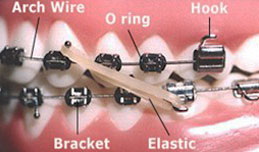Orthodontic Treatments in Brookfield
Orthodontic FAQs
WHAT AGE SHOULD MY CHILD HAVE AN ORTHODONTIC EVALUATION?
At The Fun Kid’s Dentist, we offer a variety of kids orthodontics treatments in Brookfield, WI, including braces, retainers, and more; but you may be wondering when is the right time to take your child in for an evaluation? The American Association of Orthodontists (AAO) recommends an orthodontic screening for children by the age of 7 years. At age 7 the teeth and jaws are developed enough so that the dentist or orthodontist can see if there will be any serious bite problems in the future. Most of the time treatment is not necessary at age 7, but it gives the parents and dentist time to watch the development of the patient and decide on the best mode of treatment. When you have time on your side you can plan ahead and prevent the formation of serious problems.
WHY IS IT IMPORTANT TO HAVE ORTHODONTIC TREATMENT AT A YOUNG AGE?
Research has shown that serious orthodontic problems can be more easily corrected when the patient’s skeleton is still growing and flexible. By correcting the skeletal problems at a younger age we can prepare the mouth for the eventual eruption of the permanent teeth. If the permanent teeth have adequate space to erupt they will come in fairly straight. If the teeth erupt fairly straight their tendency to get crooked again after the braces come off is diminished significantly. After the permanent teeth have erupted, usually from age 12-14, complete braces are placed for final alignment and detailing of the bite. Thus the final stage of treatment is quicker and easier on the patient. This phase of treatment usually lasts from 12 - 18 months and is not started until all of the permanent teeth have erupted.
We do invisalign and orthodontic treatments at our Brookfield dental office in two steps, because it provides excellent results, often allowing the doctor to avoid removal of permanent teeth and jaw surgery. The treatment done when some of the baby teeth are still present is called Phase-1. The last part of treatment after all the permanent teeth have erupted is called Phase-2.
WHAT CAUSES CROOKED TEETH?
Crowded teeth, thumb sucking, tongue thrusting, premature loss of baby teeth, a poor breathing airway caused by enlarged adenoids or tonsils can all contribute to poor tooth positioning. And then there are the hereditary factors. Extra teeth, large teeth, missing teeth, wide spacing, small jaws - all can be causes of crowded teeth.
HOW DO TEETH MOVE?
Tooth movement is a natural response to light pressure over a period of time. Pressure is applied by using a variety of orthodontic hardware (appliances), the most common being a brace or bracket attached to the teeth and connected by an archwire. Periodic changing of these arch wires puts pressure on the teeth. At different stages of treatment, your child may wear headgear, elastics, a positioner or a retainer. Most orthodontic appointments at our Brookfield office are scheduled 4 to 6 weeks apart to give the teeth time to move.
WILL IT HURT?
When teeth are first moved, discomfort may result. This usually lasts about 24 to 72 hours. Patients report a lessening of pain as the treatment progresses. Pain medicines such as acetaminophen (Tylenol) or ibuprofen (Advil) usually help relieve the pain.
Orthodontic Terms
ARCH WIRE
 The part of your braces that actually moves the teeth. The arch wire is attached to the brackets by small elastic donuts or ligature wires. Arch Wires are changed throughout the treatment. Each change brings you closer to the ideal tooth position.
The part of your braces that actually moves the teeth. The arch wire is attached to the brackets by small elastic donuts or ligature wires. Arch Wires are changed throughout the treatment. Each change brings you closer to the ideal tooth position.
BRACKETS
Brackets are the “Braces” or small attachments that are bonded directly to the tooth surface. The brackets are the part of your braces to which the dentist or assistant attaches the arch wire.
Occasionally, a bracket may come loose and become an irritation to your mouth. You can remove the loose bracket and save it in an envelope to bring to the office. Call Brookfield’s braces and invisalign experts at The Fun Kid’s Dentist as soon as possible and make an appointment to re-glue the bracket.
ELASTICS (RUBBER BANDS)
At some time during treatment, it will be necessary to wear elastics to coordinate the upper and lower teeth and perfect the bite. Once teeth begin to move in response to elastics, they move rapidly and comfortably. If elastics (rubber bands) are worn intermittently, they will continually "shock" the teeth and cause more soreness. When elastics are worn one day and left off the next, treatment slows to a standstill or stops. Sore teeth between appointments usually indicate improper wear of headgear or elastics or inadequate hygiene. Wear your elastics correctly, attaching them as you were told. Wear elastics all the time, unless otherwise directed. Take your elastics off while brushing. Change elastics as directed, usually once or twice a day.

